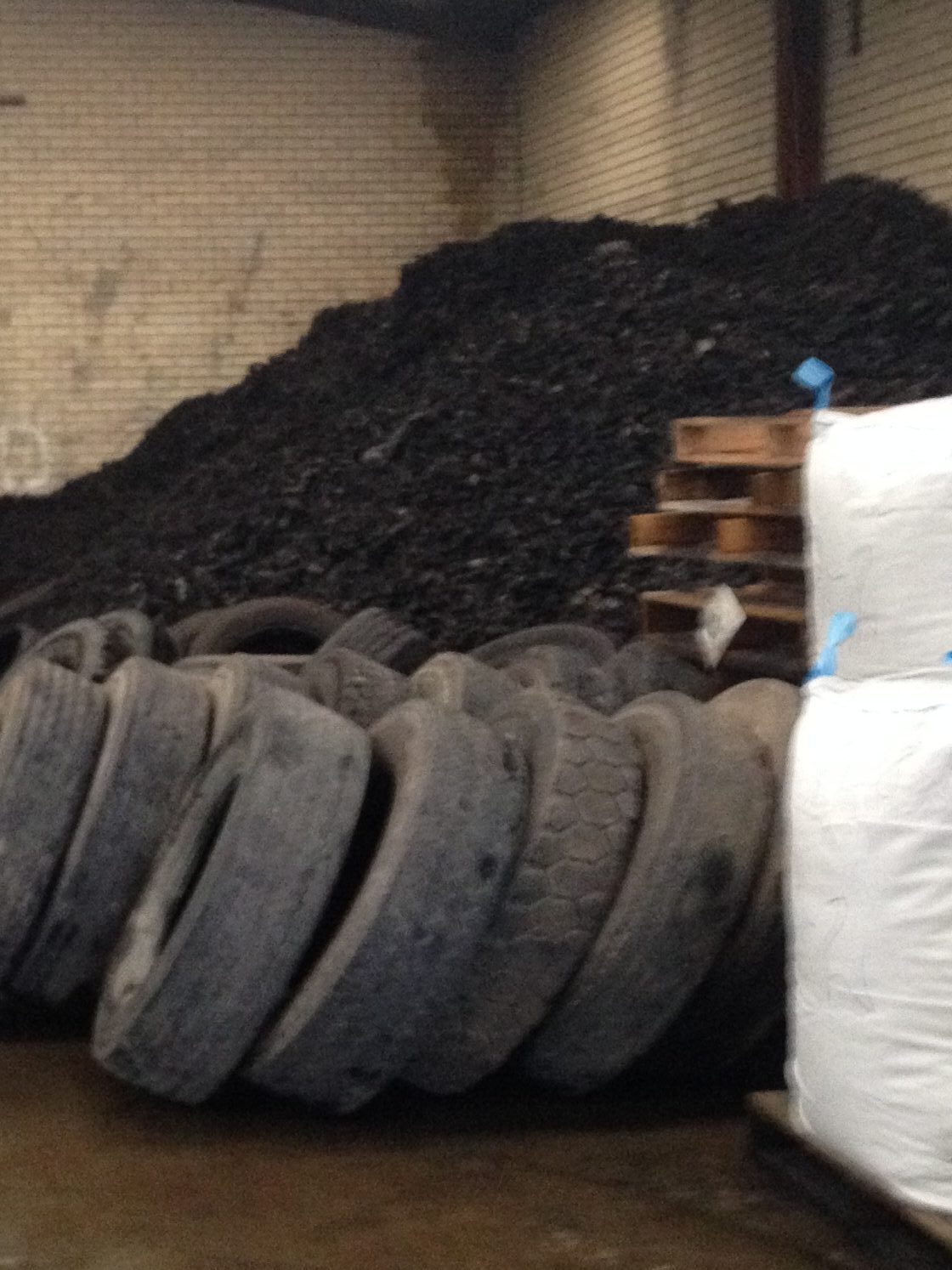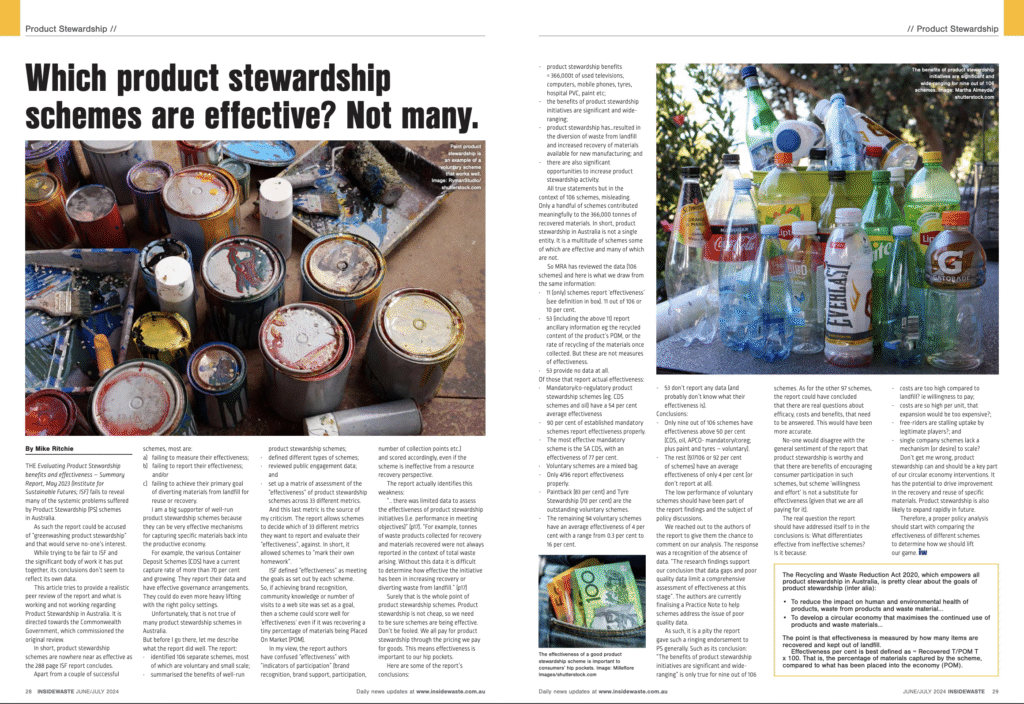Product Stewardship scheme effectiveness
By: Mike Ritchie, MRA Consulting Group

“Evaluating Product Stewardship benefits and effectiveness – SUMMARY REPORT, May 2023” (Institute for Sustainable Futures; ISF) report fails to reveal many of the systemic problems suffered by Product Stewardship (PS) schemes in Australia.
As such the report could be accused of “greenwashing PS” and that would serve no-one’s interest.
Whilst trying to be fair to ISF and the significant body of work they have put together, their conclusions don’t seem to reflect their own data.
This article tries to provide a realistic peer review of the report and what is working and not working regarding Product Stewardship (PS) in Australia. It is particularly directed towards the Commonwealth Government which commissioned the original review.
In short PS Schemes are nowhere near as effective as the 288 page ISF report concludes.
In fact, apart from a couple of very successful schemes, most are:
- Failing to measure their effectiveness;
- Failing to report their effectiveness; and/or
- Failing to achieve their primary goal of diverting materials from landfill for reuse or recovery.
I am a big supporter of well-run PS schemes because they can be very effective mechanisms for capturing specific materials back into the productive economy.
For example, the various Container Deposit Schemes (CDS) have a current capture rate of over 70% and growing, they report their data and have effective governance arrangements. They could do even more heavy lifting with the right policy settings.
Unfortunately, that is not true of many (most) PS schemes in Australia.
But before I go there, let me describe what the Report did well. The report:
- identified 106 separate schemes, most of which are voluntary and small scale;
- summarised the benefits of well-run PS schemes;
- defined different types of schemes;
- reviewed public engagement data; and
- set up a matrix of assessment of the “Effectiveness” of PS schemes across 33 different metrics.
And this last metric is the source of my criticism. The report allows schemes to decide which of 33 different metrics they want to report and evaluate their “effectiveness”, against. In short, it allowed schemes to “mark their own homework”.
ISF defined “effectiveness” as meeting the goals as set out by each scheme. So, if achieving brand recognition, community knowledge or number of visits to a web site was set as a goal, then a scheme could score well for ‘effectiveness’ even if it was recovering a tiny percentage of materials being Placed On Market (POM).
In my view, the Report authors have confused “Effectiveness” with “Indicators of Participation” (brand recognition, brand support, participation, number of collection points etc.) and scored accordingly, even if the scheme is ineffective from a resource recovery perspective.
Tweet
The Report actually identifies this very weakness:
“.. there was limited data to assess the effectiveness of product stewardship initiatives (i.e. performance in meeting objectives)” (p17). “For example, tonnes of waste products collected for recovery and materials recovered were not always reported in the context of total waste arising. Without this data it is difficult to determine how effective the initiative has been in increasing recovery or diverting waste from landfill.” (p17)
Surely that is the whole point of PS schemes. PS is not cheap, so we need to be sure schemes are being effective. Don’t be fooled. We all pay for PS through the pricing we pay for goods. So, effectiveness is important to our hip pockets!
Here are some of the report’s conclusions:
- “Product Stewardship benefits = 366,000t of used televisions, computers, mobile phones, tyres, hospital PVC, paint etc….
- The benefits of PS initiatives are significant and wide-ranging;
- PS has … resulted in the diversion of waste from landfill and increased recovery of materials available for new manufacturing;
- There are also significant opportunities to increase product stewardship activity.
All true statements but in the context of 106 schemes, very misleading.
| The Recycling and Waste Reduction Act 2020, which empowers all Product Stewardship in Australia, is pretty clear about the goals of PS (inter alia):To reduce the impact on human and environmental health of products, waste from products and waste material…To develop a circular economy that maximises the continued use of products and waste materials…The point is that Effectiveness is measured by how many items are recovered and kept out of landfill. Effectiveness % is best defined as = Recovered T/POM T x 100.That is, the percentage of materials captured by the Scheme, compared to what has been placed into the economy (POM). |
Only a handful of schemes contributed meaningfully to the 366,000 tonnes of recovered materials.
In short, PS in Australia is not a single entity. It is a multitude of schemes some of which are effective and many of which are not.
So MRA has reviewed the data (106 schemes) and here is what we draw from the same information:
- 11 (only) schemes report ‘Effectiveness’ (see definition in box). 11 out of 106 or 10%.
- 53 (including the above 11) report ancillary information e.g. the recycled content of the products POM or the rate of recycling of the materials once collected. But these are not measures of Effectiveness.
- 53 provide no data at all.
Of those that report actual Effectiveness:
- Mandatory/Coregulatory PS schemes (e.g. CDS schemes and oil) have a 54% average Effectiveness.
- 90% of established mandatory schemes report Effectiveness properly.
- The most effective mandatory scheme is the SA CDS, with an effectiveness of 77%.
- Voluntary schemes are a mixed bag.
- Only 4/96 report Effectiveness properly.
- Paintback (83%) and Tyre Stewardship (70%) are the outstanding voluntary schemes.
- The remaining 94 voluntary schemes have an average effectiveness of 4% with a range from 0.3% to 16%.
- 53 don’t report any data (and probably don’t know what their Effectiveness is).

Conclusions:
- Only 9 out of 106 schemes have effectiveness above 50% (CDS, oil, APCO- mandatory/coreg; plus Paint and Tyres- voluntary).
- The rest (97/106 or 92% of schemes) have an average Effectiveness of only 4% (or don’t report at all).
The low performance of voluntary schemes should surely have been part of the Report findings and the subject of policy discussions.
We reached out to the authors of the report to give them the chance to comment on our analysis. The response was a recognition of the absence of data “The research findings support our conclusion that data gaps and poor quality data limit a comprehensive assessment of effectiveness at this stage”. In fact, the authors are currently finalising a Practice Note to help schemes address the issue of poor quality data.
As such it is a pity the report gave such a ringing endorsement to PS generally. Such as its conclusion: “The benefits of PS initiatives are significant and wide-ranging” is only true for 9 out of 106 schemes. As for the other 97 schemes the report could have concluded that there are real questions about efficacy, costs and benefits, that need to be answered. This would have been far more accurate.
No-one would disagree with the general sentiment of the report that PS is worthy and that there are benefits of encouraging consumer participation in PS, but scheme ‘willingness and effort’ is not a substitute for Effectiveness (given that we are all paying for it).
The real question the Report should have addressed itself to in the conclusions is What differentiates Effective from Ineffective Schemes?
Is it because:
- Costs are too high compared to landfill? ie Willingness to Pay;
- Costs are so high per unit, that expansion would be too expensive?
- Free-riders are stalling uptake by legitimate players?
- Single company schemes lack a mechanism (or desire) to scale?
Don’t get me wrong. Product Stewardship can and should, be a key part of our Circular Economy interventions. It has the potential to drive significant improvement in the recovery and reuse of specific materials. PS is also likely to expand rapidly in future.
Therefore, a proper policy analysis should start with comparing the Effectiveness of different schemes to determine how we should lift our game.
.
Mike Ritchie is the Managing Director at MRA Consulting Group.
This article has been published by the following media outlets:





